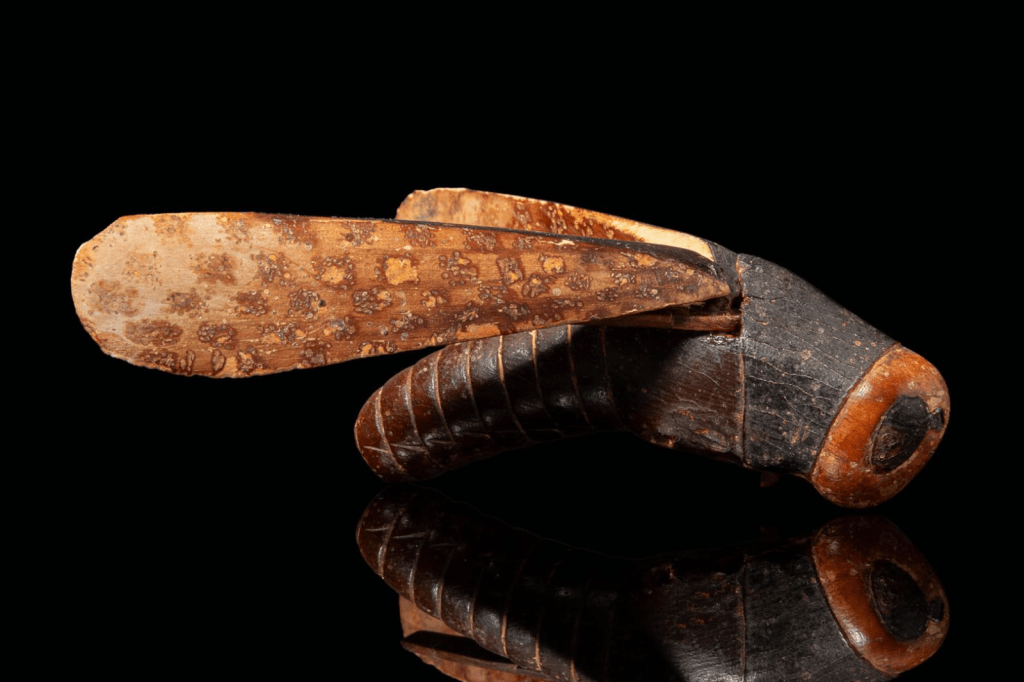An intricately carved grasshopper made of ivory and wood “from the Age of Tutankhamun” is set to be sold by a small auction house on July, reports the New York Times.
However, Egyptian art historians have raised concerns that the cosmetic vessel was possibly stolen by Howard Carter, the British archaeologist who discovered King Tutankhamen’s tombs. Carter spent years cataloging thousands of items found inside the tomb, a number of which, some allege, illicitly entered his own collection.
Apollo Art Auctions has listed the insect-shaped artifact intended to hold kohl or perfume as the “Guennol Grasshopper” with an estimate of £300,000 to £500,000 (approximately $400,000 to $675,000). The auction house also noted it originally sold for 1.2 million USD, and comes with the original invoice.
Related Articles

The grasshopper features a segmented body, upper wings made from painted ivory and decorated with a checkerboard pattern, wooden lower wings, and a head inset with black eyes. “The wings swing outward to reveal a small oval cavity”, the auction house noted.
Promotional materials on the object’s provenance stated “the vessel passed into the hands of major 20th-century collectors including New York’s Joseph Brummer and the fabled Guennol Collection before being acquired by the Merrin Gallery in 2007 accompanied by its original invoice.”
The Guennol Collection belonged to longtime Brooklyn Museum trustee Alastair Bradley Martin and his wife, Edith. In December 2007, a limestone figure of a Lionness (circa 3000-2800 B.C.) from the collection sold for $57.1 million with fees, on a high estimate of $18 million at Sotheby’s in New York.
The auction house also noted the vessel artifact was exhibited at the Brooklyn Museum from 1948 to 2002 and at the Metropolitan Museum of Art in 1969.
In an emailed statement to the New York Times, the auction house said there was “no documented evidence” that the vessel came from the boy king’s tomb. “The item does not appear on any official excavation inventories,” the statement said.
But Christian Loeben, a German Egyptologist and curator at the Museum August Kestner in Hanover, Germany, told the New York Times he was “quite convinced” the grasshopper did come from the famous tomb, due to its lack of damage indicating origins from a sealed chamber and its style existing in Egypt at “exactly the period” of the pharaoh’s reign.
The auction house also noted the grasshopper was cleared against the Art Loss Register database of stolen artifacts and comes with an Art Loss Letter, a “certificate of clearance” from the London-based company.
Even with serious questions from experts about the artifact’s origins, because the Egyptian government has never reported it stolen or asked for its return, James Ratcliffe, general counsel and director of recoveries at the Art Loss Register told the Times the grasshopper was in “an awkward area”.
And while the Egyptian government has not filed a claim on the object, experts like Thomas Hoving, a former director of the Metropolitan Museum of Art, have linked it to King Tutankhamen’s tomb for several decades, including in written works like Hoving’s “Tutankhamun: The Untold Story”, first published by Simon and Schuster in 1978.
After Carter died, his niece discovered items among his belongings inscribed with Tutankhamen’s name, and some were returned to Egypt. In 2010, the Metropolitan Museum of Art also returned 19 small scale objects from its collection after research produced “detailed evidence leading us to conclude without doubt” they came from his tomb.
Loeben, who has also written about Carter’s archaeology career, also said the artifact should be returned to Egypt. “It’s a moral question.”

